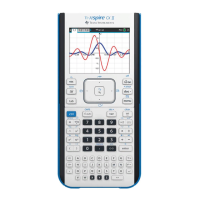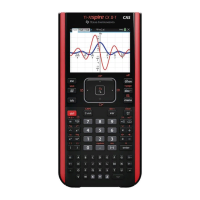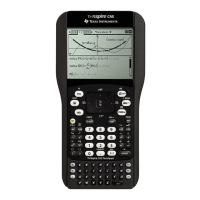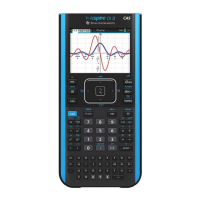TI-Nspire™ Reference Guide 39
freqTable4list()
Catalog
>
freqTable
4
list(List1,freqIntegerList) ⇒ list
Returns a list containing the elements from List1 expanded according
to the frequencies in freqIntegerList. This function can be used for
building a frequency table for the Data & Statistics application.
List1 can be any valid list.
freqIntegerList must have the same dimension as List1 and must
contain non-negative integer elements only. Each element specifies
the number of times the corresponding List1 element will be
repeated in the result list. A value of zero excludes the corresponding
List1 element.
Note: You can insert this function from the computer keyboard by
typing freqTable@>list(...).
Empty (void) elements are ignored. For more information on empty
elements, see page 131.
frequency()
Catalog
>
frequency(List1,binsList) ⇒ list
Returns a list containing counts of the elements in List1. The counts
are based on ranges (bins) that you define in binsList.
If binsList is {b(1), b(2), …, b(n)}, the specified ranges are {?{b(1),
b(1)<?{b(2),…,b(n-1)<?{b(n), b(n)>?}. The resulting list is one
element longer than binsList.
Each element of the result corresponds to the number of elements
from List1 that are in the range of that bin. Expressed in terms of the
countIf() function, the result is { countIf(list, ?{b(1)), countIf(list,
b(1)<?{b(2)), …, countIf(list, b(n-1)<?{b(n)), countIf(list, b(n)>?)}.
Elements of List1 that cannot be “placed in a bin” are ignored.
Empty (void) elements are also ignored. For more information on
empty elements, see page 131.
Within the Lists & Spreadsheet application, you can use a range of
cells in place of both arguments.
Note: See also countIf(), page 23.
Explanation of result:
2 elements from Datalist are {2.5
4 elements from Datalist are >2.5 and {4.5
3 elements from Datalist are >4.5
The element “hello” is a string and cannot be placed in any of
the defined bins.
FTest_2Samp
Catalog
>
FTest_2Samp List1,List2[,Freq1[,Freq2[,Hypoth]]]
FTest_2Samp
List1,List2[,Freq1[,Freq2[,Hypoth]]]
(Data list input)
FTest_2Samp sx1,n1,sx2,n2[,Hypoth]
FTest_2Samp
sx1,n1,sx2,n2[,Hypoth]
(Summary stats input)
Performs a two-sample F test. A summary of results is stored in the
stat.results variable. (See page 97.)
For H
a
: s1 > s2, set Hypoth>0
For H
a
: s1 ƒ s2 (default), set Hypoth =0
For H
a
: s1 < s2, set Hypoth<0
For information on the effect of empty elements in a list, see “Empty
(void) elements” on page 131.

